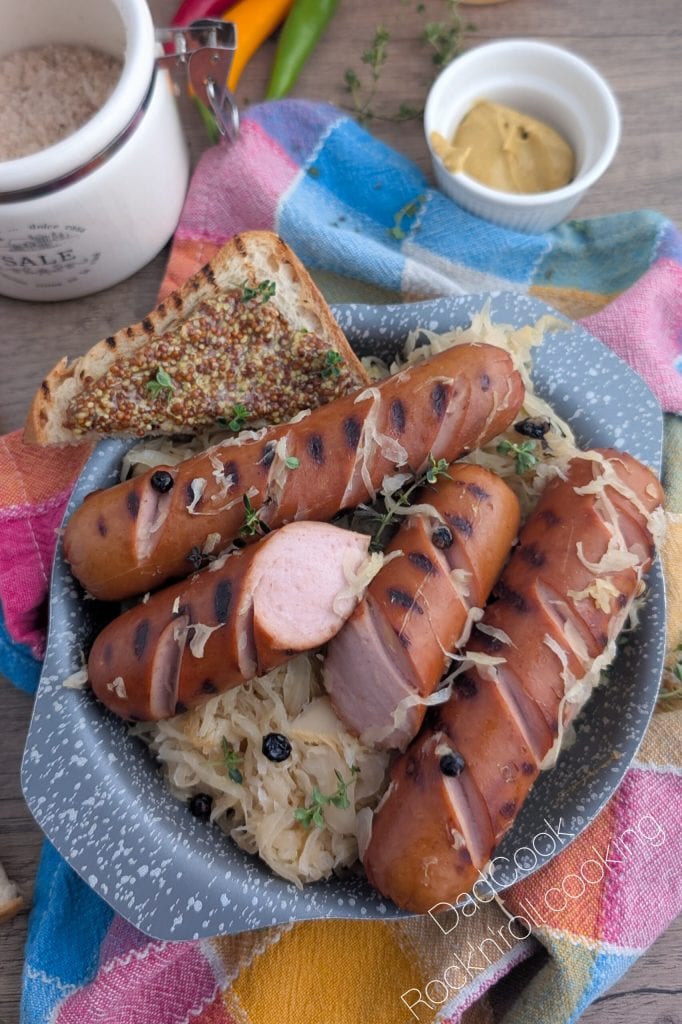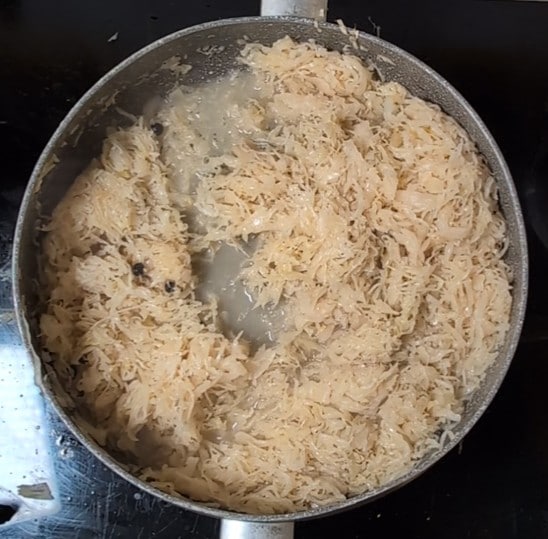In the heart of Bavarian culinary tradition, where simplicity meets authentic taste, a dish is born that warms the soul: sausages and sauerkraut.
But we’re not talking about the usual sausages, rather, authentic pork delicacies with an incredible percentage of meat, where each bite is an explosion of genuine flavor.
And the sauerkraut? Ah, the sauerkraut… How many times, during my travels in Germany, have I wondered what the secret was to that softness, that succulence that made them so different from ours. And to think that, in most cases, they were always canned sauerkraut!
After countless tastings and some ‘information stolen’ from waiters, I finally understood.
In this recipe, I will reveal the secret to transforming simple sauerkraut into a rich and aromatic side dish, capable of enhancing the succulence of the sausages.
Get ready for a journey of taste, where tradition and innovation meet in perfect harmony.

- Difficulty: Very easy
- Cost: Very cheap
- Rest time: 2 Minutes
- Preparation time: 10 Minutes
- Portions: 4
- Cooking methods: Stovetop
- Cuisine: German
- Seasonality: All seasons
- Energy 269.76 (Kcal)
- Carbohydrates 6.80 (g) of which sugars 1.87 (g)
- Proteins 12.40 (g)
- Fat 22.00 (g) of which saturated 7.83 (g)of which unsaturated 11.97 (g)
- Fibers 3.25 (g)
- Sodium 1,465.51 (mg)
Indicative values for a portion of 280 g processed in an automated way starting from the nutritional information available on the CREA* and FoodData Central** databases. It is not food and / or nutritional advice.
* CREATES Food and Nutrition Research Center: https://www.crea.gov.it/alimenti-e-nutrizione https://www.alimentinutrizione.it ** U.S. Department of Agriculture, Agricultural Research Service. FoodData Central, 2019. https://fdc.nal.usda.gov
Ingredients
Before diving into the heart of the preparation, let’s discover together the protagonists of this culinary journey. Each ingredient, carefully chosen, contributes to creating a perfect balance of flavors and aromas, transforming a simple dish into an unforgettable experience.
- 4 raw pure pork sausages
- 500 g precooked sauerkraut
- 7 oz vegetable broth
- 3 tablespoons extra virgin olive oil
- 2 cloves garlic
- 2 leaves bay leaves
- Half cup dry white wine
- 1 tablespoon apple cider vinegar
- A few berries juniper berries
- A few grains black pepper
- 4 tablespoons fennel seeds
Tools
To transform these ingredients into a dish worth licking your lips, we’ll need a few essential tools.
Let’s discover together the allies that will accompany us on this culinary adventure, making the preparation simple and pleasant.
- 1 Frying Pan Lagostina
- 1 Grill Pan Zanetti
Steps
Now that we have all the ingredients and tools at hand, it’s time to bring our dish to life.
Follow these simple steps and, step by step, we’ll transform quality ingredients into a memorable culinary experience.
The Aromatic Sauté and Scented Sauerkraut:
In a large pan, heat the extra virgin olive oil and gently brown the garlic. Add the broken bay leaves, juniper berries, and black peppercorns, allowing the aromas to release.
When the garlic is golden, remove it along with the bay leaves.
At this point, pour in the well-drained sauerkraut and fennel seeds, stirring to flavor.
Deglaze with the dry white wine, let the alcohol evaporate, then add the apple cider vinegar and hot vegetable broth.
Cover and stew over low heat for about 20 minutes, stirring occasionally, until the sauerkraut is tender and the broth has reduced.

Preparing the Sausages:
While the sauerkraut is cooking, take care of the sausages.
Open them from the package and pat them dry with paper towels.
If you prefer, you can cut them in half, or leave them whole with slight cuts on the surface.
This will ensure even cooking and make them even tastier.

Grilling and Final Cooking:
Heat a grill pan well.For a crispy touch, lightly toast some bread slices. Then, on the same grill pan, grill the sausages for a few minutes, until they are golden and have inviting grill marks.
Transfer the sausages to the pan with the sauerkraut, mix gently, and continue cooking for another 5-10 minutes, covered, until the broth has further reduced and the sausages are perfectly cooked.

Plating and Serving:
Serve the sausages and sauerkraut hot immediately.
Place a generous portion of sauerkraut on the plate, lay the grilled sausages, and accompany with toasted bread slices.
For a final touch, add a teaspoon of whole grain mustard (or classic mustard, if you prefer) next to the sausages.
The contrast between the sweetness of the sauerkraut, the succulence of the sausages, and the spiciness of the mustard will make this dish an unforgettable experience.

Even the most delicious dish can have leftovers, or you might want to personalize it to suit your tastes.
In this section, I’ll give you some useful tips on how to best preserve sausages and sauerkraut, suggestions to enhance their flavor, and ideas for creative variations.
Storage, Tips, and Variations:
Storage:
In the fridge: store leftover sausages and sauerkraut in an airtight container for up to 2-3 days.
Reheating: gently reheat in a pan or microwave, adding a bit of broth or water if necessary, to prevent them from drying out.
Tips:
For a more intense flavor, you can add diced smoked bacon during the initial sauté. *
If you don’t have dry white wine, you can substitute it with vegetable broth or apple juice.
Serve the sausages and sauerkraut with side dishes like boiled potatoes, mashed potatoes, or mustard for a complete meal.
To further enrich the taste, you can add diced apples during the cooking of the sauerkraut.
Variations:
Sweet and sour sauerkraut: add raisins and sugar during cooking for a sweet and sour touch.
Sausages and sauerkraut with beer: replace the white wine with light beer for a more robust flavor.
Vegetarian version: replace the sausages with vegetable sausages or smoked tofu.
Addition of other spices: you can enrich the sauerkraut with other spices like cumin or paprika for a more complex flavor.

FAQ (Questions and Answers)
We have gathered some of the most frequently asked questions about sausages and sauerkraut to help you resolve any doubts and get the most out of this recipe.
Can I use fresh sauerkraut instead of canned ones?
Sure! Fresh sauerkraut is a great alternative. You’ll need to cook them a bit longer, about 30-40 minutes, until they are tender.

I don’t have juniper berries, can I use other spices?
Absolutely! Cumin is a great addition to sauerkraut. Add a teaspoon of cumin seeds during the sauté for a warm, aromatic flavor. You can also experiment with coriander seeds or smoked paprika.

Can I prepare sausages and sauerkraut in advance?
Yes, you can prepare the sauerkraut in advance and reheat them when serving. Add the grilled sausages just at the last minute to avoid them becoming too soft.

How can I make the sauerkraut less acidic?
You can add a pinch of sugar or a tablespoon of honey during cooking to balance the acidity of the sauerkraut. Adding grated apple can also help reduce the acidity.
Can I freeze leftover sausages and sauerkraut?
Freezing sauerkraut is not recommended, as their texture may suffer. Cooked sausages can be frozen, but they may become slightly drier once thawed.

